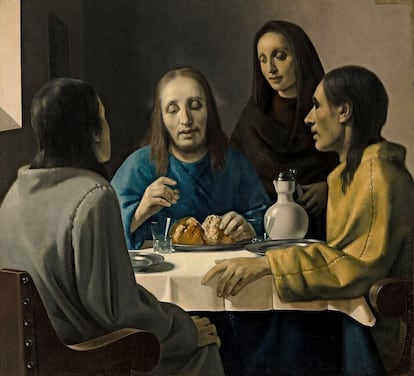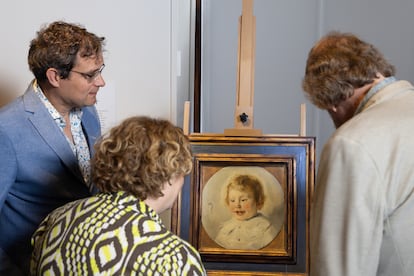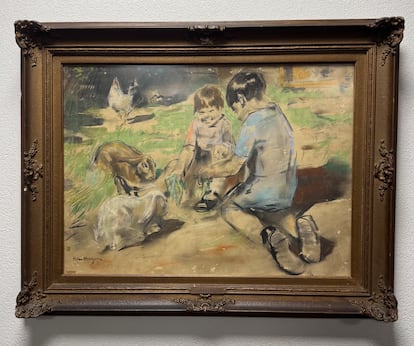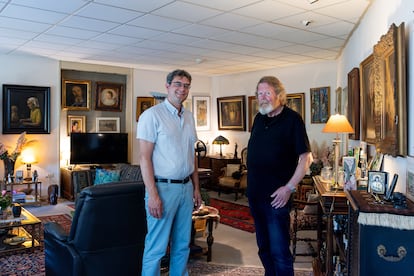Han van Meegeren, one of the greatest forgers of the 20th century, will have his own museum in the Netherlands.

In 1947, just after the end of World War II, a strange trial took place in the Netherlands. The defendant was Han van Meegeren, a 58-year-old painter accused of looting national cultural property. He was accused of selling the painting Christ and the Woman in Adultery, by the Golden Age master Johannes Vermeer , to none other than the Nazi Hermann Goering, commander-in-chief of the German Air Force. But it was not a case of collaboration. The defendant admitted to being the true artist of the painting and claimed that the one titled The Disciples at Emmaus, exhibited at the Boijmans van Beuningen Museum in Rotterdam, It was also his own, not Vermeer's. He even claimed to have executed a handful more . Convicted of fraud and dying shortly after, his hometown of Deventer is preparing a museum to display his works from 2026: those bearing his authentic signature and several forgeries.
The permanent exhibition will mark the homecoming of the most famous imposter in the history of Dutch art , who wanted to make it on his own, but whose classical style was out of step with the avant-garde movements of the 20th century. A man driven by greed, whose National Socialist sympathies during the German occupation of the Netherlands remain a subject of study. “Art forgers are often complicated and unhappy people,” says American Edward Dolnick, author of The Forger's Spell , in an email. The book recounts Van Meegeren's near-perfect crime, and the writer reminds us in his message that “it's not good for the soul when people walk past your work without paying attention when it bears your name, but are left speechless when it's by someone else.” At the same time, Dolnick warns that “greed was a stronger motivation than wounded pride.”
Han van Meegeren was born in 1889 into a deeply devout Catholic family. His father didn't want him to become an artist and forced him to study architecture. He also made him write hundreds of times: "I know nothing, I am nothing, I am capable of nothing." The boy enrolled at the Delft Technical School between 1907 and 1913, and although he easily passed his exams, he failed the final test. Bartus Korteling, a painter friend, instructed him in the style of the 17th-century masters, and when he won a university gold medal for an oil painting of a church interior, the die was cast.

As a professional painter, he was popular and enjoyed some sales success. “He lacked critical acclaim, but he wasn't a failure,” says Ewout van der Horst, director of Deventer Verhaal , the foundation that promotes the preservation of the city's cultural heritage in eastern Germany. He says that Van Meegeren “had a lot of expenses due to his fondness for luxury, and we want to tell the story of a tormented man through his work.” The foundation has purchased around thirty of his paintings from a local collector named Theo Bakker for the exhibition. Bakker, whose house was lined with Van Meegeren paintings , does believe he was a forger “because critics dismissed his work as decorative and worthless,” he says over the phone.
Divorced from his first wife and with two children, the artist settled in the south of France with his second wife in 1932. There, he experimented for years with white lead, indigo, cinnabar, and lapis lazuli until he found the right mixture. Two things were missing: a 17th-century canvas and something to make the pigments look antique. He solved the first by purchasing an authentic canvas from the period, which he scraped with a pumice stone to erase the original. Then he came up with the idea of adding Bakelite to the paint, a synthetic resin that hardened it as it dries over time.

Once the painting was finished, he would place it in a kiln at around 100 degrees Celsius and then roll it onto a cylinder. This created the craquelure, the cracks that appear on canvases due to aging, which he then filled with India ink. He finished with opaque varnish. He first executed a work in the style of the Flemish painter Frans Hals, but it was withdrawn from an auction for being a forgery without revealing its authorship. He also made a couple of tests in the style of Vermeer , although he didn't sell them. In 1936, he completed The Disciples at Emmaus. It depicts the Gospel passage in which the risen Christ appears to them on the way to the village of the same name. The deception exceeded his expectations, and there was no turning back.
In 1937, The Disciples at Emmaus reached Abraham Bredius, the most respected expert of his time, through an intermediary. As soon as he declared it a Vermeer masterpiece, a scramble broke out to purchase it. The asking price was 520,000 florins, and it was eventually acquired by a wealthy shipowner who donated it to the Boijmans van Beuningen, the museum reports. Part of Van Meegeren's success is explained by the fact that he captured the atmosphere conducive to the appearance of an early Vermeer painting, generated in the Netherlands by art historians themselves. They argued that he must have painted religious themes when he was not as recognizable as in the famous Girl with a Pearl Earring . Did the scientific controls fail then?

It's a paradox that Edward Dolnick explains thus: "Art experts and scientists often come from different worlds and distrust each other." He adds that, in this case, there was a strong group element, and "once the critics recognized the forgery as authentic, the majority followed suit." Van Meegeren remained in the shadows with the sale, became a millionaire, and continued forging until, in 1942, Christ and the Adulterous Woman fell into the hands of Hermann Goering, the Nazi leader. It was another supposed Vermeer, and in the midst of the war, it was difficult to compare it with the originals. Goering paid 1.6 million florins and believed he owned a jewel.
Although Van Meegeren also never met Goering, his alleged National Socialist affiliations "are very bad news politically," according to Dolnick. Meanwhile, in his book "The Man Who Made Vermeers ," American art historian Jonathan López argues that the Dutchman was a swindler and an opportunist. He writes that he needed money and took advantage of the Nazi occupation, even though he sympathized with that ideology. Since everything was recorded in German bureaucracy, when the Allied forces found Christ and the Adulterous Woman At the Austrian castle of Fischhorn, they pulled the thread of merchants and messengers until they reached Van Meegeren. It was the beginning of the end, but a spectacular twist remained.

To avoid being accused of treason, the painter had to admit in 1945 that he was a forger. They didn't believe him, and he then declared before the judges that he could prove it. The court accepted the challenge and set up an apartment in Amsterdam for him to paint a Vermeer-style painting. He publicly painted Jesus and the Scribes in the Temple, and the trial opened in October 1947. The hearings had international repercussions, especially because he defended himself by saying that the important thing was that he had deceived Goering: the enemy. The image of mocking the occupier resonated with his compatriots, and he became almost a hero. Sentenced to a year in prison, he died that same December, suffering from addictions to alcohol, tobacco, and morphine. "Van Meegeren is an important figure for what he tells us about credulity and swindlers," argues Edward Dolnick. What if he also fueled the desire for hidden treasures in art to remain?
EL PAÍS

%3Aformat(jpg)%3Aquality(99)%3Awatermark(f.elconfidencial.com%2Ffile%2Fbae%2Feea%2Ffde%2Fbaeeeafde1b3229287b0c008f7602058.png%2C0%2C275%2C1)%2Ff.elconfidencial.com%2Foriginal%2Fc76%2F696%2F723%2Fc76696723af3498010519efd24884ae4.jpg&w=3840&q=100)

%3Aformat(jpg)%3Aquality(99)%3Awatermark(f.elconfidencial.com%2Ffile%2Fbae%2Feea%2Ffde%2Fbaeeeafde1b3229287b0c008f7602058.png%2C0%2C275%2C1)%2Ff.elconfidencial.com%2Foriginal%2Fc54%2Fae0%2Ffd7%2Fc54ae0fd74aba825f788c7433a71b5ae.jpg&w=3840&q=100)

%3Aformat(jpg)%3Aquality(99)%3Awatermark(f.elconfidencial.com%2Ffile%2Fbae%2Feea%2Ffde%2Fbaeeeafde1b3229287b0c008f7602058.png%2C0%2C275%2C1)%2Ff.elconfidencial.com%2Foriginal%2F8cd%2Fa96%2F365%2F8cda963658eee2b225027abb1082e3e5.jpg&w=3840&q=100)